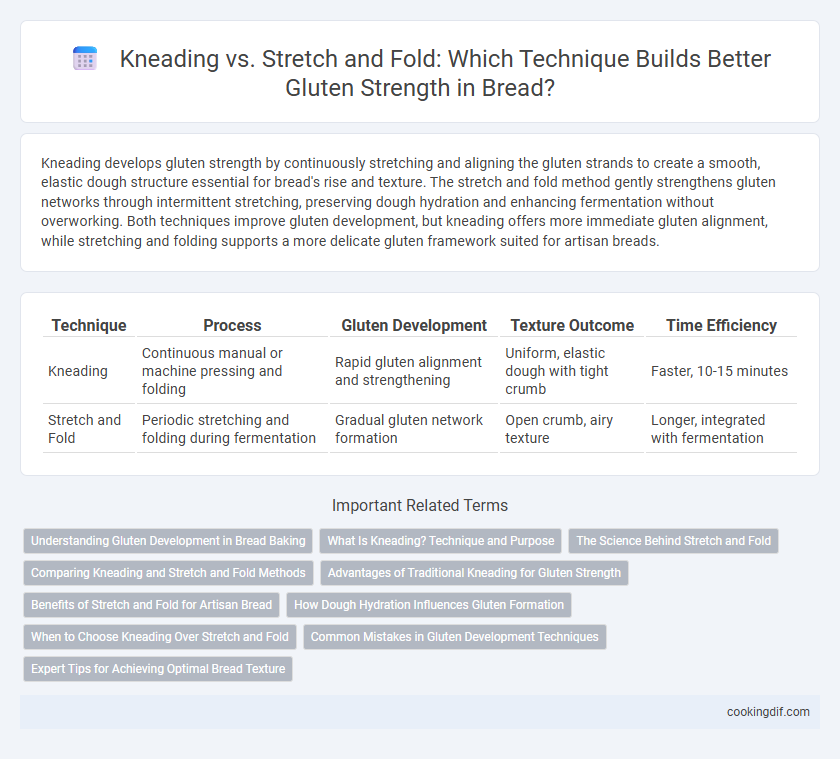Kneading develops gluten strength by continuously stretching and aligning the gluten strands to create a smooth, elastic dough structure essential for bread's rise and texture. The stretch and fold method gently strengthens gluten networks through intermittent stretching, preserving dough hydration and enhancing fermentation without overworking. Both techniques improve gluten development, but kneading offers more immediate gluten alignment, while stretching and folding supports a more delicate gluten framework suited for artisan breads.
Table of Comparison
| Technique | Process | Gluten Development | Texture Outcome | Time Efficiency |
|---|---|---|---|---|
| Kneading | Continuous manual or machine pressing and folding | Rapid gluten alignment and strengthening | Uniform, elastic dough with tight crumb | Faster, 10-15 minutes |
| Stretch and Fold | Periodic stretching and folding during fermentation | Gradual gluten network formation | Open crumb, airy texture | Longer, integrated with fermentation |
Understanding Gluten Development in Bread Baking
Kneading mechanically aligns gluten strands, creating a strong, elastic network essential for bread's structure and chew. Stretch and fold methods gently develop gluten by periodically stretching the dough, preserving gas bubbles and improving crumb texture. Both techniques enhance gluten development but differ in intensity, impacting dough strength and final bread quality.
What Is Kneading? Technique and Purpose
Kneading is a manual or mechanical process that develops gluten strength by stretching and aligning gluten strands in dough, essential for bread's structure and elasticity. This technique involves pressing, folding, and pushing the dough repeatedly to create a smooth, elastic texture that traps gas bubbles during fermentation. The purpose of kneading is to transform sticky, uneven dough into a cohesive, extensible mass capable of rising properly and producing a well-structured crumb.
The Science Behind Stretch and Fold
Stretch and fold techniques enhance gluten network development by gently aligning gluten strands, promoting elasticity without overworking the dough. This method preserves gas bubbles while evenly distributing gluten proteins, resulting in a well-structured crumb and improved dough strength. Scientific analysis shows that stretch and fold encourage hydration and gluten cross-linking more effectively than traditional kneading, leading to superior bread texture.
Comparing Kneading and Stretch and Fold Methods
Kneading develops gluten strength by applying continuous pressure and stretching, creating a smooth, elastic dough through mechanical action. The stretch and fold method gently builds gluten structure by periodically stretching the dough and folding it over itself, enhancing dough elasticity while preserving gas bubbles for better crumb texture. Comparing both techniques, kneading is faster and more intense, ideal for firmer doughs, whereas stretch and fold offers a gentler approach suited for high-hydration, artisanal bread with open crumb.
Advantages of Traditional Kneading for Gluten Strength
Traditional kneading actively develops gluten by aligning and tightening gluten strands through continuous pressure and motion, resulting in a strong, elastic dough structure. This method allows for immediate tactile feedback, enabling bakers to adjust dough texture and hydration for optimal gluten formation. Consistent kneading enhances gas retention during fermentation, which improves crumb structure and overall bread volume.
Benefits of Stretch and Fold for Artisan Bread
Stretch and fold technique enhances gluten strength by gently aligning gluten strands without overworking the dough, preserving air bubbles essential for artisan bread's open crumb. This method improves dough elasticity and extensibility, resulting in a better rise and a more complex texture compared to traditional kneading. Artisan bakers benefit from stretch and fold by achieving superior dough structure and enhanced flavor development through controlled fermentation.
How Dough Hydration Influences Gluten Formation
Dough hydration significantly impacts gluten development, with higher hydration levels enabling more effective gluten matrix formation through stretch and fold techniques by allowing gluten strands to align and strengthen without overworking the dough. Kneading works best in lower hydration doughs, promoting gluten formation through repetitive folding and pressing that encourages protein bonding in denser textures. Optimal hydration balances water absorption and gluten elasticity, enhancing dough extensibility and resulting in superior crumb structure and chewiness in bread.
When to Choose Kneading Over Stretch and Fold
Kneading is preferred over stretch and fold when a dough requires rapid development of strong gluten networks, especially for lean breads like baguettes or pizza dough that demand high elasticity and structure. Intensive kneading aligns gluten strands more effectively in a shorter time, making it ideal for doughs with high hydration or for recipes needing quick fermentation. Stretch and fold techniques are better suited for high-hydration or enriched doughs where gentle gluten formation and gas retention are critical, but kneading excels when consistent, tight gluten structure is necessary.
Common Mistakes in Gluten Development Techniques
Kneading often leads to overworking the dough, causing gluten to become too tight and resulting in a dense crumb, while the stretch and fold method promotes better gluten alignment without overdevelopment. Common mistakes include excessive kneading that tears gluten strands and improper timing for stretch and fold, which can weaken gluten structure if done too early or too late. Maintaining correct hydration and gentle handling ensures optimal gluten strength, crucial for bread texture and rise.
Expert Tips for Achieving Optimal Bread Texture
Kneading develops gluten by continuously stretching and aligning the dough, resulting in a strong, elastic network essential for a chewy bread texture. Stretch and fold technique gently strengthens gluten while preserving dough hydration and open crumb structure, ideal for high-hydration artisanal loaves. Expert bakers recommend combining both methods--initial kneading for structure followed by periodic stretch and folds to optimize gluten strength and texture without overworking the dough.
Kneading vs Stretch and Fold for gluten strength Infographic

 cookingdif.com
cookingdif.com